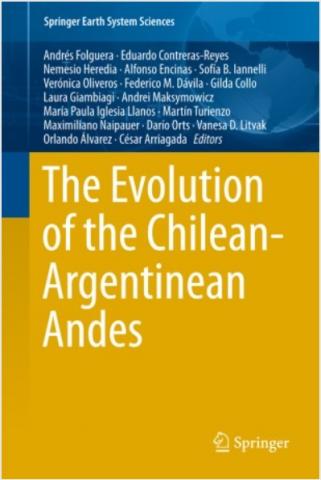Libro: The Evolution of the Chilean-Argentinean Andes

Capítulo: Paleogeographic and Kinematic Constraints in the Tectonic Evolution of
the Pre-Andean Basement Blocks. pp 83-109.
Autores: Augusto E. Rapalini, Silvana E. Geuna, Pablo R. Franceschinis, Cecilia M. Spagnuolo
Abstract

Formation of the south Central Andes basement cannot be unlinked from the final stages of Western Gondwana amalgamation. This process is still matter of much debate and continuous research. In the last two decades, a picture has emerged that suggests that the accretion and/or displacement of discrete crustal blocks in the Ediacaran and Early Paleozoic was a major process that finally configured the basement upon which three hundred million years later the Andean orogen developed. A main crustal fragment of the basement of central Argentina is the Pampia terrane. Recent, but still scarce, paleomagnetic results on Cambrian rocks from this terrane show anomalous pole positions whose interpretation is still ambiguous. Whether Pampia is a cortical fragment linked to the Amazonian craton that collided against the Rio de la Plata craton coetaneously with the closure of the hypothetical Clymene Ocean, whether it was attached previously and subsequently collided with a western crustal sliver (Western Pampia) associated with the Arequipa-Antofalla terrane, or whether it was a fragment detached from southern Kalahari that was displaced along the margin of the Río de la Plata craton in the Cambrian, cannot be unambiguously solved due to the scarcity of paleomagnetic data. It is generally accepted that the very long magmatic belt along the western boundary of Pampia in the Ordovician (the Famatinian arc) developed on stretched continental crust. Systematic large clockwise rotation of Ordovician magmatic and sedimentary rocks along this belt has been confirmed in recent years, but the originally para-autochthonous rotated terrane model has been replaced by one in which a systematic pattern of small crustal block rotations accompanied deformation due to collision of the allochthnous Cuyania terrane. The very large counterclockwise rotations in the Western Puna (Antofalla terrane) of Chile and Argentina are still interpreted by some authors as evidence of closure of a V-shaped back-arc basin between Antofalla (and Arequipa?) and the Western Gondwana margin in the Late Ordovician. However, the interpretation of such rotations as due to tectonic escape of the Antofalla block during Cuyania collision may be more compatible with geochemical signatures that suggest crustal links between the Sierras Pampeanas and the Puna basements. Paleomagnetic support for the Laurentian origin of the Cuyania terrane has endured the significant improvement of the apparent polar wander path for Gondwana in the Ediacaran–Cambrian. Alternative models suggesting a para-autochthonous origin of Cuyania are difficult to reconcile with different lines of evidence (biogeographic, isotopic) and are not supported by available paleomagnetic data for this terrane. Whether Chilenia is a truly allochtonous terrane or a fragment of Cuyania that rifted apart to collide back in the Devonian is still controversial. Unfortunately, paleomagnetic data are not available to test these models yet.
